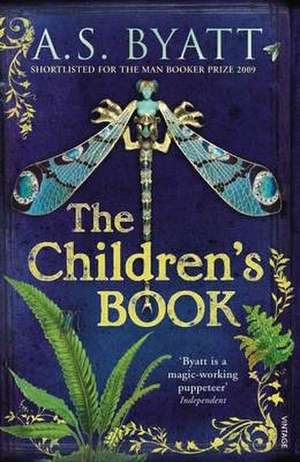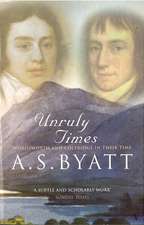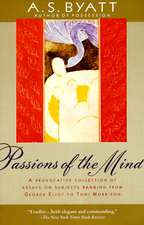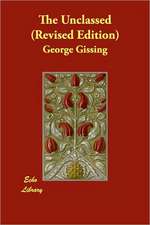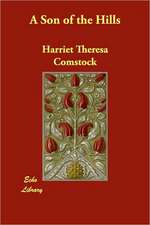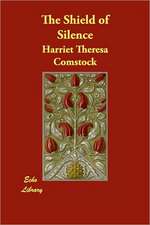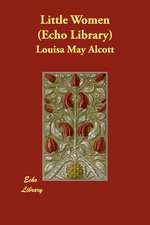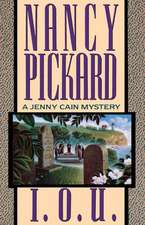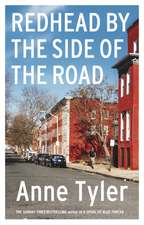The Children's Book
Autor A. S. Byatten Limba Engleză Paperback – 7 ian 2010
| Toate formatele și edițiile | Preț | Express |
|---|---|---|
| Paperback (2) | 62.81 lei 24-30 zile | +28.25 lei 4-10 zile |
| Vintage Publishing – 7 ian 2010 | 62.81 lei 24-30 zile | +28.25 lei 4-10 zile |
| Vintage Books USA – 31 iul 2010 | 142.51 lei 3-5 săpt. |
Preț: 62.81 lei
Preț vechi: 72.27 lei
-13% Nou
Puncte Express: 94
Preț estimativ în valută:
12.02€ • 13.06$ • 10.11£
12.02€ • 13.06$ • 10.11£
Carte disponibilă
Livrare economică 03-09 aprilie
Livrare express 14-20 martie pentru 38.24 lei
Preluare comenzi: 021 569.72.76
Specificații
ISBN-13: 9780099535454
ISBN-10: 0099535459
Pagini: 624
Dimensiuni: 130 x 197 x 36 mm
Greutate: 0.46 kg
Editura: Vintage Publishing
Locul publicării:United Kingdom
ISBN-10: 0099535459
Pagini: 624
Dimensiuni: 130 x 197 x 36 mm
Greutate: 0.46 kg
Editura: Vintage Publishing
Locul publicării:United Kingdom
Notă biografică
A. S. Byatt is the author of numerous novels, including the quartet The Virgin in the Garden, Still Life, Babel Tower and A Whistling Woman; The Biographer’s Tale; and Possession, which was awarded the Booker Prize. She has also written two novellas, published together as Angels & Insects; five collections of shorter works, including The Matisse Stories and Little Black Book of Stories; and several works of nonfiction. A distinguished critic as well as a novelist, she lives in London.
Extras
Two boys stood in the Prince Consort Gallery, and looked down on a third. It was June 19th, 1895. The Prince had died in 1861, and had seen only the beginnings of his ambitious project for a gathering of museums in which the British craftsmen could study the best examples of design. His portrait, modest and medalled,was done inmosaic in the tympanum of a decorative arch at one end of the narrowgallery which ran above the space of the South Court. The South Court was decorated with further mosaics, portraits of painters, sculptors, potters, the "Kensington Valhalla." The third boy was squatting beside one of a series of imposing glass cases displaying gold and silver treasures. Tom, the younger of the two looking down, thought of Snow White in her glass coffin. He thought also, looking up at Albert, that the vessels and spoons and caskets, gleaming in the liquid light under the glass, were like a resurrected kingly burial hoard. (Which, indeed, some of them were.) They could not see the other boy clearly, because he was on the far side of a case. He appeared to be sketching its contents.
Julian Cain was at home in the South Kensington Museum. His father, Major Prosper Cain, was Special Keeper of Precious Metals.
Julian was just fifteen, and a boarder at Marlowe School, but was home recovering from a nasty bout of jaundice. He was neither tall nor short, slightly built, with a sharp face and a sallow complexion, even without the jaundice. He wore his straight black hair parted in the centre, and was dressed in a school suit. Tom Wellwood, boyish in Norfolk jacket and breeches, was about two years younger, and looked younger than he was, with large dark eyes, a soft mouth and a smooth head of dark gold hair. The two had not met before. Tom's mother was visiting Julian's father, to ask for help with her research. She was a successful authoress of magical tales. Julian had been deputed to show Tom the treasures. He appeared to be more interested in showing him the squatting boy.
"I said I'd show you a mystery."
"I thought you meant one of the treasures."
"No, I meant him. There's something shifty about him. I've been keeping an eye on him. He's up to something."
Tom was not sure whether this was the sort of make-believe his own family practised, tracking complete strangers and inventing stories about them. He wasn't sure if Julian was, so to speak, playing at being responsible.
"What does he do?"
"He does the Indian rope trick. He disappears. Now you see him, now you don't. He's here every day. All by himself. But you can't see where or when he goes."
They sidled along the wrought-iron gallery, which was hung with thick red velvet curtains. The third boy stayed where he was, drawing intently. Then he moved his position, to see from another angle. He was hay-haired, shaggy and filthy. He had cut-down workmen's trousers, with braces, over a flannel shirt the colour of smoke, stained with soot. Julian said
"We could go down and stalk him. There are all sorts of odd things about him. He looks very rough. He never seems to go anywhere but here. I've waited at the exit to see him leave, and follow him, and he doesn't seem to leave. He seems to be a permanent fixture."
The boy looked up, briefly, his grimy face creased in a frown. Tom said
"He concentrates."
"He never talks to anyone that I can see. Now and then the art students look at his drawings. But he doesn't chat to them. He just creeps about the place. It's sinister."
"Do you get many robberies?"
"My father always says the keepers are criminally casual with the keys to the cases. And there are heaps and heaps of stuff lying around waiting to be catalogued, or sent to Bethnal Green. It would be terribly easy to sneak off with things. I don't even know if anyone would notice if you did, not with some of the things, though they'd notice quickly enough if anyone made an attempt on the Candlestick."
"Candlestick?"
"The Gloucester Candlestick. What he seems to be drawing, a lot of the time. The lump of gold, in the centre of that case. It's ancient and unique. I'll show it to you. We could go down, and go up to it, and disturb him." Tom was dubious about this. There was something tense about the third boy, a tough prepared energy he didn't even realise he'd noticed.
However, he agreed. He usually agreed to things. They moved, sleuthlike, from ambush to ambush behind the swags of velvet. They went under Prince Albert, out onto the turning stone stairs, down to the South Court. When they reached the Candlestick, the dirty boy was not there.
"He wasn't on the stairs," said Julian, obsessed.
Tom stopped to stare at the Candlestick. It was dully gold. It seemed heavy. It stood on three feet, each of which was a long-eared dragon, grasping a bone with grim claws, gnawing with sharp teeth. The rim of the spiked cup that held the candle was also supported by open-jawed dragons with wings and snaking tails. The whole of its thick stem was wrought of fantastic foliage, amongst which men and monsters, centaurs and monkeys, writhed, grinned, grimaced, grasped and stabbed at each other. A helmeted, gnomelike being, with huge eyes, grappled the sinuous tail of a reptile. There were other human or kobold figures, one
in particular with long draggling hair and a mournful gaze. Tom thought immediately that hismotherwould need to see it. He tried, and failed, to memorise the shapes. Julian explained. It had an interesting history, he said. No one knew exactly what it was made of. It was some kind of gilt alloy. Itwas probable that it had been made in Canterbury—modelled in wax and cast—but apart from the symbols of the evangelists on the knop, it appeared not to be made for a religious use. It had turned up in the cathedral in Le Mans, from where it had disappeared during the French Revolution. A French antiquary had sold it to the Russian Prince Soltikoff. The South KensingtonMuseum had acquired it from his collection in 1861. There was nothing, anywhere, like it.
Tom did not know what a knop was, and did not know what the symbols of the evangelists were. But he saw that the thing was a whole world of secret stories. He said his mother would like to see it. It might be just what she was looking for. He would have liked to touch the heads of the dragons.
Julian was looking restlessly around him. There was a concealed door, behind a plaster cast of a guarding knight, on a marble plinth. It was slightly ajar, which he had never seen before. He had tried its handle, and it was always, as it should be, since it led down to the basement storerooms and workrooms, locked.
"I bet he went down there."
"What's down there?"
"Miles and miles of passages and cupboards and cellars, and things being moulded, or cleaned, or just kept. Let's stalk him."
There was no light, beyond what was cast on the upper steps from the door they had opened. Tom did not like the dark. He did not like transgression. He said "We can't see where we're going."
"We'll leave the door open a crack."
"Someone may come and lock it. We may get into trouble."
"We won't. I live here."
They crept down the uneven stone steps, holding a thin iron rail. At the foot of the staircase they found themselves cut off by a metal grille, beyond which stretched a long corridor, now vaguely visible as though there was a light-source at the other end. The passage was roofed with Gothic vaulting, like a church crypt, but finished in white glazed industrial bricks. Julian gave the grille an irritated shake and it swung open. He observed that this, too, should have been locked. Someone was in for trouble.
The passage opened into a dusty vault, crammed with a crowd of white effigies, men, women and children, staring out with sightless eyes. Tom thought they might be prisoners in the underworld, or even the damned. They were closely packed; the boys had to worm their way between them. Beyond this funereal chamber, two corridors branched. There was more light to the left, so they went that way, negotiated another unlocked grille, and found themselves in a treasure-house of vast gold and silver vessels, croziers, eagle-winged lecterns, fountains, soaring angels and grinning cherubs. "Electrotypes," whispered the knowledgeable Julian. A faint but steady light rippled over the metal, through little glass roundels let into the brickwork. Julian put his finger
to his lips and hissed to Tom to keep still. Tom steadied himself against a silver galleon, which clanged. He sneezed.
"Don't do that."
"I can't help it. It's the dust."
They crept on, took a left, took a right, had to force their way between thickets of what Tom thought were tomb railings, surmounted by jaunty female angel-busts,with wings and pointed breasts. Julian said they were cast-iron radiator covers, commissioned from an ironmaster in Sheffield. "Cost a packet, down here because someone thought they were obtrusive," he whispered. "Which way now?"
Tom said he had no idea. Julian said they were lost, no one would find them, rats would pick their bones. Someone sneezed. Julian said
"I told you, don't do that."
"I didn't. It must have been him."
Tom was worried about hunting down a probably harmless and innocent boy. He was also worried about encountering a savage and
dangerous boy.
Julian cried "We knowyou're there. Come out and give yourself up!"
He was alert and smiling, Tom saw, the successful seeker or catcher in games of pursuit.
There was a silence. Another sneeze. A slight scuffling. Julian and
Tom turned to look down the other fork of the corridor, which was obstructed by a forest of imitation marble pillars, made to support busts or vases. A wild face, under a mat of hair, appeared at knee height, framed between fake basalt and fake obsidian.
"You'd better come out and explain yourself," said Julian, with complete certainty. "You're trespassing. I should get the police."
The third boy came out on all fours, shook himself like a beast, and stood up, supporting himself briefly on the pillars. He was about Julian's height. He was shaking, whether with fear or wrath Tom could not tell. He pushed a dirty hand across his face, rubbing his eyes, which even in the gloom could be seen to be red-rimmed. He put his head down, and tensed. Tom saw the thought go through him, he could charge the two of them, head-butt them and flee down the corridors. He didn't move and didn't answer.
"What are you doing down here?" Julian insisted.
"I were hiding."
"Why? Hiding from who?"
"Just hiding. I were doing no harm. I move carefully. I don't disturb things."
"What's your name? Where do you live?"
"My name's Philip. Philip Warren. I suppose I live here. At present."
His voice was vaguely north country.Tomrecognised it, but couldn't place it. He was looking at them much as they were looking at him, as though he couldn't quite grasp that they were real. He blinked, and a tremor ran through him. Tom said
"You were drawing the Candlestick. Is that what you came for?"
"Aye."
He was clutching a kind of canvas satchel against his chest, which presumably contained his sketching materials. Tom said
"It's an amazing thing, isn't it? I hadn't seen it before."
The other boy looked him in the eye, then, with a flicker of a grin.
"Aye. Amazing, it is."
Julian spoke severely.
"You must come and explain yourself to my father."
"Oh, your father. Who's he, then?"
"He's Special Keeper of Precious Metals."
"Oh. I see."
"You must come along with us."
"I see I must. Can I get my things?"
"Things?" Julian sounded doubtful for the first time. "You mean, you've been living down here?"
"S'what I said. I got nowhere else to go. I'd rather not sleep on t'streets. I come here to draw. I saw the Museum was for workingmen to see well-made things. I mean to get work, I do, and I need drawings to show . . . I like these things."
"Can we see the drawings?" asked Tom.
"Not in this light. Upstairs, if you're interested. I'll get my things, like I said."
He ducked, and began to make his way back amongst the pillars, crouching and weaving expertly. Tom was put in mind of dwarves in mine-workings, and, since his upbringing was socially conscientious, of children in mines, pulling trucks on hands and knees. Julian was on Philip's heels. Tom followed.
"Come in," said the grimy boy, at the opening of a small storeroom, making a welcoming gesture, possibly mocking, with an arm. The storeroom contained what appeared to be a small stone hut, carved and ornamented with cherubim and seraphim, eagles and doves, acanthus and vines. It had its own little metal gate, with traces of gilding on the rusting iron.
"Convenient," said Philip. "It has a stone bed. I took the liberty of borrowing some sacks to keep warm. I'll put 'em back, naturally, where I found them."
"It's a tomb or shrine," said Julian. "Russian, by the look of it. There must have been some saint on that table, in a glass case or a reliquary.
He might still be in there, underneath, his bones that is, if he wasn't incorrupt."
"I haven't noticed him," said Philip, flatly. "He hasn't bothered me."
Tom said "Are you hungry? What do you eat?"
"Once or twice I got to help in the tea-room, moving plates and washing them. People leave a lot on their plates, you'd be surprised. And the young ladies from the Art School took notice of my drawings and sometimes they passed me a sandwich. I don't beg. I did steal one, once, when I was desperate, an egg-and-cress sandwich. I were pretty sure the
young lady had no intention of eating it."
He paused.
"It isn't much," he said. "I'm hungry, yes."
He was rummaging behind the tomb in the shrine, and came out with another canvas satchel, a sketch-book, a candle stub and what looked like a roll of clothing, tied with string.
"How did you get in?" Julian persisted.
"Followed the horses and carts. You know, they turn in and drive down a ramp into these underground parts. And they unload and pack things with a deal of bustle, and it's easy enough to mingle wi' them, wi' the carters and lads, and get in."
"And the upstairs door?" Julian queried. "Which is meant to be locked at all times."
"I came across a little key."
"Came across?"
"Aye. Came across. I'll give it back. Here, take it."
Tom said
"It must be horribly frightening, down here alone at night."
"Not near so frightening as t'streets in t'East End. Not near."
Julian said "Please come with me now. You must come and explain all this to my father. He's talking to Tom's mother. This is Tom. Tom Wellwood. I'm Julian Cain."
From the Hardcover edition.
Julian Cain was at home in the South Kensington Museum. His father, Major Prosper Cain, was Special Keeper of Precious Metals.
Julian was just fifteen, and a boarder at Marlowe School, but was home recovering from a nasty bout of jaundice. He was neither tall nor short, slightly built, with a sharp face and a sallow complexion, even without the jaundice. He wore his straight black hair parted in the centre, and was dressed in a school suit. Tom Wellwood, boyish in Norfolk jacket and breeches, was about two years younger, and looked younger than he was, with large dark eyes, a soft mouth and a smooth head of dark gold hair. The two had not met before. Tom's mother was visiting Julian's father, to ask for help with her research. She was a successful authoress of magical tales. Julian had been deputed to show Tom the treasures. He appeared to be more interested in showing him the squatting boy.
"I said I'd show you a mystery."
"I thought you meant one of the treasures."
"No, I meant him. There's something shifty about him. I've been keeping an eye on him. He's up to something."
Tom was not sure whether this was the sort of make-believe his own family practised, tracking complete strangers and inventing stories about them. He wasn't sure if Julian was, so to speak, playing at being responsible.
"What does he do?"
"He does the Indian rope trick. He disappears. Now you see him, now you don't. He's here every day. All by himself. But you can't see where or when he goes."
They sidled along the wrought-iron gallery, which was hung with thick red velvet curtains. The third boy stayed where he was, drawing intently. Then he moved his position, to see from another angle. He was hay-haired, shaggy and filthy. He had cut-down workmen's trousers, with braces, over a flannel shirt the colour of smoke, stained with soot. Julian said
"We could go down and stalk him. There are all sorts of odd things about him. He looks very rough. He never seems to go anywhere but here. I've waited at the exit to see him leave, and follow him, and he doesn't seem to leave. He seems to be a permanent fixture."
The boy looked up, briefly, his grimy face creased in a frown. Tom said
"He concentrates."
"He never talks to anyone that I can see. Now and then the art students look at his drawings. But he doesn't chat to them. He just creeps about the place. It's sinister."
"Do you get many robberies?"
"My father always says the keepers are criminally casual with the keys to the cases. And there are heaps and heaps of stuff lying around waiting to be catalogued, or sent to Bethnal Green. It would be terribly easy to sneak off with things. I don't even know if anyone would notice if you did, not with some of the things, though they'd notice quickly enough if anyone made an attempt on the Candlestick."
"Candlestick?"
"The Gloucester Candlestick. What he seems to be drawing, a lot of the time. The lump of gold, in the centre of that case. It's ancient and unique. I'll show it to you. We could go down, and go up to it, and disturb him." Tom was dubious about this. There was something tense about the third boy, a tough prepared energy he didn't even realise he'd noticed.
However, he agreed. He usually agreed to things. They moved, sleuthlike, from ambush to ambush behind the swags of velvet. They went under Prince Albert, out onto the turning stone stairs, down to the South Court. When they reached the Candlestick, the dirty boy was not there.
"He wasn't on the stairs," said Julian, obsessed.
Tom stopped to stare at the Candlestick. It was dully gold. It seemed heavy. It stood on three feet, each of which was a long-eared dragon, grasping a bone with grim claws, gnawing with sharp teeth. The rim of the spiked cup that held the candle was also supported by open-jawed dragons with wings and snaking tails. The whole of its thick stem was wrought of fantastic foliage, amongst which men and monsters, centaurs and monkeys, writhed, grinned, grimaced, grasped and stabbed at each other. A helmeted, gnomelike being, with huge eyes, grappled the sinuous tail of a reptile. There were other human or kobold figures, one
in particular with long draggling hair and a mournful gaze. Tom thought immediately that hismotherwould need to see it. He tried, and failed, to memorise the shapes. Julian explained. It had an interesting history, he said. No one knew exactly what it was made of. It was some kind of gilt alloy. Itwas probable that it had been made in Canterbury—modelled in wax and cast—but apart from the symbols of the evangelists on the knop, it appeared not to be made for a religious use. It had turned up in the cathedral in Le Mans, from where it had disappeared during the French Revolution. A French antiquary had sold it to the Russian Prince Soltikoff. The South KensingtonMuseum had acquired it from his collection in 1861. There was nothing, anywhere, like it.
Tom did not know what a knop was, and did not know what the symbols of the evangelists were. But he saw that the thing was a whole world of secret stories. He said his mother would like to see it. It might be just what she was looking for. He would have liked to touch the heads of the dragons.
Julian was looking restlessly around him. There was a concealed door, behind a plaster cast of a guarding knight, on a marble plinth. It was slightly ajar, which he had never seen before. He had tried its handle, and it was always, as it should be, since it led down to the basement storerooms and workrooms, locked.
"I bet he went down there."
"What's down there?"
"Miles and miles of passages and cupboards and cellars, and things being moulded, or cleaned, or just kept. Let's stalk him."
There was no light, beyond what was cast on the upper steps from the door they had opened. Tom did not like the dark. He did not like transgression. He said "We can't see where we're going."
"We'll leave the door open a crack."
"Someone may come and lock it. We may get into trouble."
"We won't. I live here."
They crept down the uneven stone steps, holding a thin iron rail. At the foot of the staircase they found themselves cut off by a metal grille, beyond which stretched a long corridor, now vaguely visible as though there was a light-source at the other end. The passage was roofed with Gothic vaulting, like a church crypt, but finished in white glazed industrial bricks. Julian gave the grille an irritated shake and it swung open. He observed that this, too, should have been locked. Someone was in for trouble.
The passage opened into a dusty vault, crammed with a crowd of white effigies, men, women and children, staring out with sightless eyes. Tom thought they might be prisoners in the underworld, or even the damned. They were closely packed; the boys had to worm their way between them. Beyond this funereal chamber, two corridors branched. There was more light to the left, so they went that way, negotiated another unlocked grille, and found themselves in a treasure-house of vast gold and silver vessels, croziers, eagle-winged lecterns, fountains, soaring angels and grinning cherubs. "Electrotypes," whispered the knowledgeable Julian. A faint but steady light rippled over the metal, through little glass roundels let into the brickwork. Julian put his finger
to his lips and hissed to Tom to keep still. Tom steadied himself against a silver galleon, which clanged. He sneezed.
"Don't do that."
"I can't help it. It's the dust."
They crept on, took a left, took a right, had to force their way between thickets of what Tom thought were tomb railings, surmounted by jaunty female angel-busts,with wings and pointed breasts. Julian said they were cast-iron radiator covers, commissioned from an ironmaster in Sheffield. "Cost a packet, down here because someone thought they were obtrusive," he whispered. "Which way now?"
Tom said he had no idea. Julian said they were lost, no one would find them, rats would pick their bones. Someone sneezed. Julian said
"I told you, don't do that."
"I didn't. It must have been him."
Tom was worried about hunting down a probably harmless and innocent boy. He was also worried about encountering a savage and
dangerous boy.
Julian cried "We knowyou're there. Come out and give yourself up!"
He was alert and smiling, Tom saw, the successful seeker or catcher in games of pursuit.
There was a silence. Another sneeze. A slight scuffling. Julian and
Tom turned to look down the other fork of the corridor, which was obstructed by a forest of imitation marble pillars, made to support busts or vases. A wild face, under a mat of hair, appeared at knee height, framed between fake basalt and fake obsidian.
"You'd better come out and explain yourself," said Julian, with complete certainty. "You're trespassing. I should get the police."
The third boy came out on all fours, shook himself like a beast, and stood up, supporting himself briefly on the pillars. He was about Julian's height. He was shaking, whether with fear or wrath Tom could not tell. He pushed a dirty hand across his face, rubbing his eyes, which even in the gloom could be seen to be red-rimmed. He put his head down, and tensed. Tom saw the thought go through him, he could charge the two of them, head-butt them and flee down the corridors. He didn't move and didn't answer.
"What are you doing down here?" Julian insisted.
"I were hiding."
"Why? Hiding from who?"
"Just hiding. I were doing no harm. I move carefully. I don't disturb things."
"What's your name? Where do you live?"
"My name's Philip. Philip Warren. I suppose I live here. At present."
His voice was vaguely north country.Tomrecognised it, but couldn't place it. He was looking at them much as they were looking at him, as though he couldn't quite grasp that they were real. He blinked, and a tremor ran through him. Tom said
"You were drawing the Candlestick. Is that what you came for?"
"Aye."
He was clutching a kind of canvas satchel against his chest, which presumably contained his sketching materials. Tom said
"It's an amazing thing, isn't it? I hadn't seen it before."
The other boy looked him in the eye, then, with a flicker of a grin.
"Aye. Amazing, it is."
Julian spoke severely.
"You must come and explain yourself to my father."
"Oh, your father. Who's he, then?"
"He's Special Keeper of Precious Metals."
"Oh. I see."
"You must come along with us."
"I see I must. Can I get my things?"
"Things?" Julian sounded doubtful for the first time. "You mean, you've been living down here?"
"S'what I said. I got nowhere else to go. I'd rather not sleep on t'streets. I come here to draw. I saw the Museum was for workingmen to see well-made things. I mean to get work, I do, and I need drawings to show . . . I like these things."
"Can we see the drawings?" asked Tom.
"Not in this light. Upstairs, if you're interested. I'll get my things, like I said."
He ducked, and began to make his way back amongst the pillars, crouching and weaving expertly. Tom was put in mind of dwarves in mine-workings, and, since his upbringing was socially conscientious, of children in mines, pulling trucks on hands and knees. Julian was on Philip's heels. Tom followed.
"Come in," said the grimy boy, at the opening of a small storeroom, making a welcoming gesture, possibly mocking, with an arm. The storeroom contained what appeared to be a small stone hut, carved and ornamented with cherubim and seraphim, eagles and doves, acanthus and vines. It had its own little metal gate, with traces of gilding on the rusting iron.
"Convenient," said Philip. "It has a stone bed. I took the liberty of borrowing some sacks to keep warm. I'll put 'em back, naturally, where I found them."
"It's a tomb or shrine," said Julian. "Russian, by the look of it. There must have been some saint on that table, in a glass case or a reliquary.
He might still be in there, underneath, his bones that is, if he wasn't incorrupt."
"I haven't noticed him," said Philip, flatly. "He hasn't bothered me."
Tom said "Are you hungry? What do you eat?"
"Once or twice I got to help in the tea-room, moving plates and washing them. People leave a lot on their plates, you'd be surprised. And the young ladies from the Art School took notice of my drawings and sometimes they passed me a sandwich. I don't beg. I did steal one, once, when I was desperate, an egg-and-cress sandwich. I were pretty sure the
young lady had no intention of eating it."
He paused.
"It isn't much," he said. "I'm hungry, yes."
He was rummaging behind the tomb in the shrine, and came out with another canvas satchel, a sketch-book, a candle stub and what looked like a roll of clothing, tied with string.
"How did you get in?" Julian persisted.
"Followed the horses and carts. You know, they turn in and drive down a ramp into these underground parts. And they unload and pack things with a deal of bustle, and it's easy enough to mingle wi' them, wi' the carters and lads, and get in."
"And the upstairs door?" Julian queried. "Which is meant to be locked at all times."
"I came across a little key."
"Came across?"
"Aye. Came across. I'll give it back. Here, take it."
Tom said
"It must be horribly frightening, down here alone at night."
"Not near so frightening as t'streets in t'East End. Not near."
Julian said "Please come with me now. You must come and explain all this to my father. He's talking to Tom's mother. This is Tom. Tom Wellwood. I'm Julian Cain."
From the Hardcover edition.
Recenzii
“Majestic . . . Dazzling . . . Wonderful . . . . What you see here . . . is the strength and fire of Byatt’s imagination.” —The San Francisco Chronicle
“Bristling with life and invention. . . . A seductive work by an extraordinarily gifted writer.” —The Washington Post
“[Byatt’s] magnum opus. . . . Lushly detailed. . . . Every stitch of this tapestry is connected to the whole.” —The Seattle Times
“[A] masterpiece. . . . Her best yet.” —Newsday
“[A] ravishing epic. . . . This is a classic Byatt fusion of fact and uncannily luscious imagery, mixed in the ideal proportions: not too hot, not too cold—just right.” —Salon
“A stunning achievement: a novel of ideas that crackles with passion, energy and emotive force. . . . I did not want The Children’s Book to end . . . I wanted more of this ambitious, compelling novel, certainly Byatt’s best since Possession, and possibly her best ever.” —Patricia Hagen, Minneapolis Star Tribune
“Unforgettable. . . . Eloquent. . . . Majestic and immensely ambitious . . . with masterly skill and literary tact. . . . A monument of a novel.” —The New York Review of Books
“Supremely fulfilling . . . wondrous . . . rich with period detail and sublime storytelling. . . . A mesmerizing exploration of, well, everything: families, secrets, love, innocence, corruption, art, the desire for knowledge, nature, politics, war, sex, power. Even puppetry.” —The Miami Herald
“Spellbinding. . . . Alive . . . Potent. . . . Byatt is a master storyteller.” —O, The Oprah Magazine
“Sweeping. . . . A literary feast. . . . Byatt fills a huge canvas with the political and social changes that swept the world in those years . . . She elicits great compassion of the individual beings caught in that tableau. It’s not a tale you’ll soon forget.” —USA Today
“Intricately crafted, deeply satisfying. . . . Encompassing in scope and watch-maker precise in detail. . . . Fans of Possession, you’ve got yourself a new bedtime story.” —Yvonne Zipp, The Christian Science Monitor
“Rich, expansive. . . . Byatt is a spinner of multiple tales, adding gorgeous layers and dimensions to this fictional world.” —The Los Angeles Times
“Engaging and rewarding.” —The New Yorker
“A rich and ambitious work, steeped in ideas and capped with a lacerating final act. . . . Byatt’s penetrating, unsentimental style hits its mark. [The period] details are never less than fascinating.” —Time
“A complete and complex world, a gorgeous bolt of fiction. . . . The magic is in the way Byatt suffuses her novel with details, from the shimmery sets of a marionette show to clay mixtures and pottery glazes.” —The Atlantic Monthly
“Only Byatt could stuff this massive book so full of detail, character, and history while never losing track either of human feelings or of the sweeping, precipitous decline of the culture she documents.” —The Onion A.V. Club
“Fascinating . . . An exhilarating panorama . . . Passionate, intelligent. . . . A richly peopled narrative that encompasses an unusual breadth of artistic, intellectual, social, and political concerns . . . [Byatt is] a master builder, laying each brick of her tower with consummate skill. Here is a novel in which everything matters.” —Boston Sunday Globe
“Uncompromisingly erudite. . . . Like Possession, The Children’s Book is a tour de force of literary chameleonism and social history. . . . [It] brings to vivid life the often irreconcilable demands of being an artist and being a human being.” —The Wall Street Journal
“Wonderful, engaging. . . . A fine, rich, fully accomplished novel.” —The Dallas Morning News
“A kind of tragic fairy tale, and Byatt does fairy tales wonderfully.” —Newsweek
“A fascinating literary achievement. . . . [With a] captivating sense of language and narrative. . . . A more genuine look at young adulthood than any teenage wizards could hope to provide.” —Richmond Times-Dispatch
"Riveting. . . . As this complex novel builds toward its finale, it forgoes one of Olive's enchanting endings in favor of something closer to life." —Time Out New York
"Stunning . . . . Magnificent. . . . Intricate. . . . Matching and arguably surpassing Possession in breadth and ambition." —Bookforum
“So well-researched that The Children’s Book could well have been a consummate history of the [Edwardian] era. . . . The book brims in rich pictorial description . . . But more than that, Byatt’s book is an astute moral lesson.” —Chicago Sun-Times
“Bristling with life and invention. . . . A seductive work by an extraordinarily gifted writer.” —The Washington Post
“[Byatt’s] magnum opus. . . . Lushly detailed. . . . Every stitch of this tapestry is connected to the whole.” —The Seattle Times
“[A] masterpiece. . . . Her best yet.” —Newsday
“[A] ravishing epic. . . . This is a classic Byatt fusion of fact and uncannily luscious imagery, mixed in the ideal proportions: not too hot, not too cold—just right.” —Salon
“A stunning achievement: a novel of ideas that crackles with passion, energy and emotive force. . . . I did not want The Children’s Book to end . . . I wanted more of this ambitious, compelling novel, certainly Byatt’s best since Possession, and possibly her best ever.” —Patricia Hagen, Minneapolis Star Tribune
“Unforgettable. . . . Eloquent. . . . Majestic and immensely ambitious . . . with masterly skill and literary tact. . . . A monument of a novel.” —The New York Review of Books
“Supremely fulfilling . . . wondrous . . . rich with period detail and sublime storytelling. . . . A mesmerizing exploration of, well, everything: families, secrets, love, innocence, corruption, art, the desire for knowledge, nature, politics, war, sex, power. Even puppetry.” —The Miami Herald
“Spellbinding. . . . Alive . . . Potent. . . . Byatt is a master storyteller.” —O, The Oprah Magazine
“Sweeping. . . . A literary feast. . . . Byatt fills a huge canvas with the political and social changes that swept the world in those years . . . She elicits great compassion of the individual beings caught in that tableau. It’s not a tale you’ll soon forget.” —USA Today
“Intricately crafted, deeply satisfying. . . . Encompassing in scope and watch-maker precise in detail. . . . Fans of Possession, you’ve got yourself a new bedtime story.” —Yvonne Zipp, The Christian Science Monitor
“Rich, expansive. . . . Byatt is a spinner of multiple tales, adding gorgeous layers and dimensions to this fictional world.” —The Los Angeles Times
“Engaging and rewarding.” —The New Yorker
“A rich and ambitious work, steeped in ideas and capped with a lacerating final act. . . . Byatt’s penetrating, unsentimental style hits its mark. [The period] details are never less than fascinating.” —Time
“A complete and complex world, a gorgeous bolt of fiction. . . . The magic is in the way Byatt suffuses her novel with details, from the shimmery sets of a marionette show to clay mixtures and pottery glazes.” —The Atlantic Monthly
“Only Byatt could stuff this massive book so full of detail, character, and history while never losing track either of human feelings or of the sweeping, precipitous decline of the culture she documents.” —The Onion A.V. Club
“Fascinating . . . An exhilarating panorama . . . Passionate, intelligent. . . . A richly peopled narrative that encompasses an unusual breadth of artistic, intellectual, social, and political concerns . . . [Byatt is] a master builder, laying each brick of her tower with consummate skill. Here is a novel in which everything matters.” —Boston Sunday Globe
“Uncompromisingly erudite. . . . Like Possession, The Children’s Book is a tour de force of literary chameleonism and social history. . . . [It] brings to vivid life the often irreconcilable demands of being an artist and being a human being.” —The Wall Street Journal
“Wonderful, engaging. . . . A fine, rich, fully accomplished novel.” —The Dallas Morning News
“A kind of tragic fairy tale, and Byatt does fairy tales wonderfully.” —Newsweek
“A fascinating literary achievement. . . . [With a] captivating sense of language and narrative. . . . A more genuine look at young adulthood than any teenage wizards could hope to provide.” —Richmond Times-Dispatch
"Riveting. . . . As this complex novel builds toward its finale, it forgoes one of Olive's enchanting endings in favor of something closer to life." —Time Out New York
"Stunning . . . . Magnificent. . . . Intricate. . . . Matching and arguably surpassing Possession in breadth and ambition." —Bookforum
“So well-researched that The Children’s Book could well have been a consummate history of the [Edwardian] era. . . . The book brims in rich pictorial description . . . But more than that, Byatt’s book is an astute moral lesson.” —Chicago Sun-Times
